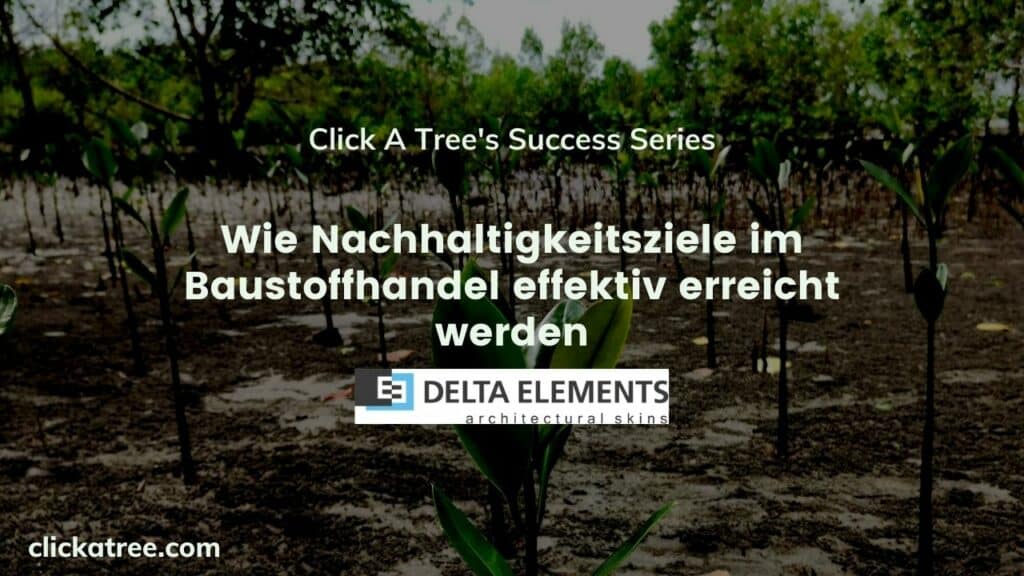Delta Elements: How to effectively achieve sustainability goals in the building materials trade
Delta Elements is a young company with a vision for the construction industry: innovative façade coverings. Their products are in demand throughout Europe and are shipped as far away as South Korea and Canada.

As transportation alone causes high CO2 emissions, Marc Gatzweiler, CEO of Delta Elements, set out to find a way to reduce the company’s environmental impact.
Here you can find out how his construction company is offsetting CO2 and achieving the sustainability goals set by the UN (SDGs) – and what its customers think.
How Delta Elements uses the ESG strategy for CO2 compensation
Delta Elements has close links with Asia, as this is where the materials for its façade coverings come from. The materials are of high quality and the façade cladding produced with them is very attractive, but the CO2 emissions generated during product manufacture are considerable.
For this reason, Marc was looking for a project with a holistic concept to fulfill as many sustainability goals as possible.

Project name: Royal residential/commercial building, D-Frankfurt am Main
Photo by Ben Knabe
When the mentor Marc met our founder Chris as part of the KIZ program, a mentoring program in Offenbach, Germany, he learned that he could meet all 17 sustainability goals by planting trees.

Every tree that is planted helps to offset the CO2 emissions caused by the logistics and transportation of goods from the factory to the construction site for years to come*.
In addition, our projects are planned in such a way that they promote training and create local jobs. “This environmental project is our contribution to sustainable commitment and social responsibility and doesn’t cost our customers a penny,” explains Marc Gatzweiler.
In this way, Marc was able to give something back by supporting our“Trees for the Seas” project in the Philippines: Jobs and a forest.
This project focuses on the reforestation of mangroves. Mangrove forests not only form a fantastic barrier that protects endangered island ecosystems, they are also a good way to achieve CO2 compensation.
Would you also like to be part of this mission? Then register on the Universal Impact Platform and let’s get started.
How CO2 compensation works
A mangrove tree absorbs around 300 kg of CO2 in the first 25 years of its life. This is a very conservative estimate – many trees absorb much more. This then changes to an average absorption of 25 kg CO2 per year.
And during this time, each mangrove tree naturally produces numerous baby trees, which then make their own considerable contribution.

Mangroves are therefore the ideal trees for offsetting high CO2 levels. So how does planting trees work for companies like Delta Elements?
With the help of Chris, Marc calculated the amount of CO2 generated by logistics and transportation from the production of the façade materials in the factory to delivery to the construction site.
Based on this amount, they estimated how many mangrove trees would have to be planted in order to achieve CO2 compensation.
A successful ESG strategy creates benefits for everyone
Due to the enormous amount of CO2 that a mangrove tree can bind during its lifetime, Delta Elements can offset its entire carbon footprint.
In addition, the company’s contribution to the “Trees for the Seas” project enables it to fulfill all 17 UN sustainability goals at the same time.
This is also appreciated by her customers. Delta Elements also provides CO2 information on the invoice to raise awareness of this important issue.
According to Managing Director Marc Gatzweiler, the integration of CO2 offsetting as part of normal business operations is even more effective than any kind of advertising: “We notice that we experience an image boost because with every delivery bill, with every copy of the delivery note, we show that we are (over)offsetting through this delivery.”
It took less than 5 minutes to sign up on the Universal Impact Platform and start planting trees.
The Universal Impact Platform offers an easy way to track your overall impact in numbers: trees planted, hours worked, education supported, plastic collected.

How achieving sustainability goals becomes a business success
The customers of this construction company understand the challenge of maximizing a company’s impact on the environment. As a result of our collaboration, Delta Elements has gained numerous sympathizers among its customers.
The simple but effective way in which Delta Elements fulfills the UN’s sustainability goals should also serve as a model for other companies. Marc explains: “I am convinced that all companies need to position themselves in this area. Every company has to play its part.”
Become a Click A Tree B4B partner
Delta Elements shows that planting trees is a simple and very effective option for companies to meet all 17 of the UN’s Sustainable Development Goals. We hope that Marc’s story has inspired you!
There are many ways in which you can integrate tree planting into your company’s ESG strategy: As a gift with a “wow” factor for customers and employees, for example, or as a great “thank you” to our planet. To help you launch your campaign, we have developed the Universal Impact Platform. It takes less than 5 minutes to sign up and get started.
If you need help creating a campaign or are interested in more information about our projects, you can contact us here. We look forward to working with you and making a valuable contribution to a future that benefits everyone.
*Since we focus on the other benefits of planting trees, such as creating jobs and living space, CO2 compensation only plays a minor role. We did not want to be seen as a pure compensation project and do not have a seal of approval for this. But of course companies can calculate how many CO2 emissions they produce and plant trees accordingly.
You can find more information about Delta Elements here.